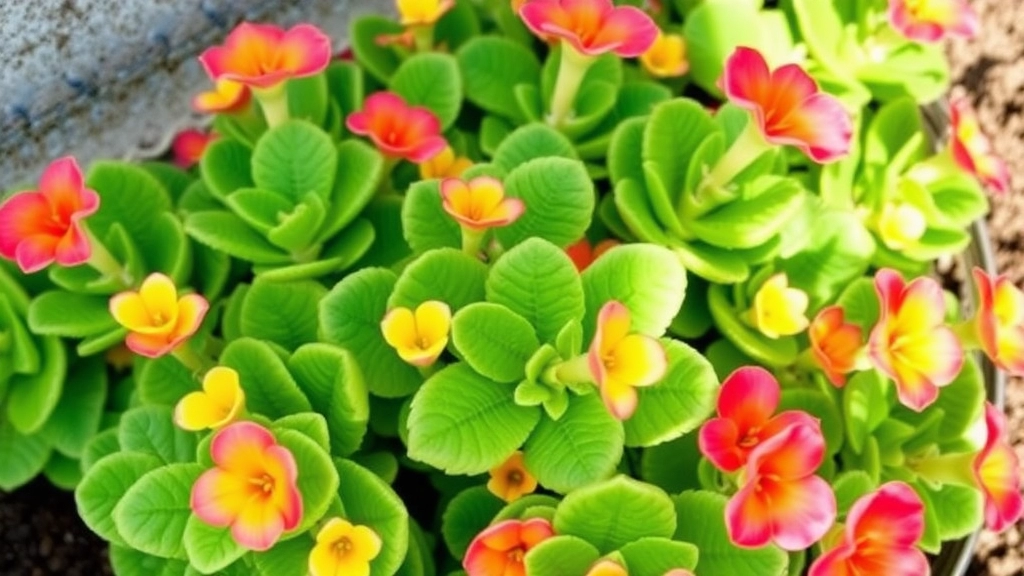Can Kalanchoe Take Full Sun?
Wondering, “Can Kalanchoe take full sun?” You’re not alone. As an avid gardener, I’ve often pondered this myself. Kalanchoe, a popular succulent, thrives in bright light but can it handle the intensity of direct sunlight all day? Let’s dig into what you need to know to keep your Kalanchoe happy and healthy.
Sunlight Resilience
When it comes to sunlight, Kalanchoe plants are quite resilient. They can indeed take full sun, but there are a few caveats. While they love bright, indirect light, placing them in full sun for extended periods can sometimes lead to sunburn. The key is to gradually acclimate your plant to more intense light, ensuring it gets the best of both worlds – ample sunlight without the risk of damage.
Kalanchoe’s Sunlight Requirements
Are you wondering how much sunlight your Kalanchoe needs to thrive?
Understanding Kalanchoe’s sunlight requirements is crucial for its health and growth.
This succulent plant flourishes in bright, indirect light but can also handle full sun conditions.
Here’s a breakdown of its sunlight needs:
- Optimal Light: Kalanchoe prefers around 6 hours of bright, indirect sunlight daily.
- Full Sun Tolerance: While it can adapt to full sun, especially in cooler climates, it’s essential to ease it into these conditions gradually.
- Indoor vs. Outdoor: If grown indoors, place your Kalanchoe near a south or west-facing window for the best results. Outdoors, ensure it’s in a spot that receives ample sunlight without harsh afternoon rays.
Now that we’ve covered its sunlight needs, let’s explore the ideal growing conditions for Kalanchoe.
For more detailed information on specific varieties, you might find our guide on Kalanchoe Pink Butterflies particularly useful.
Ideal Growing Conditions for Kalanchoe
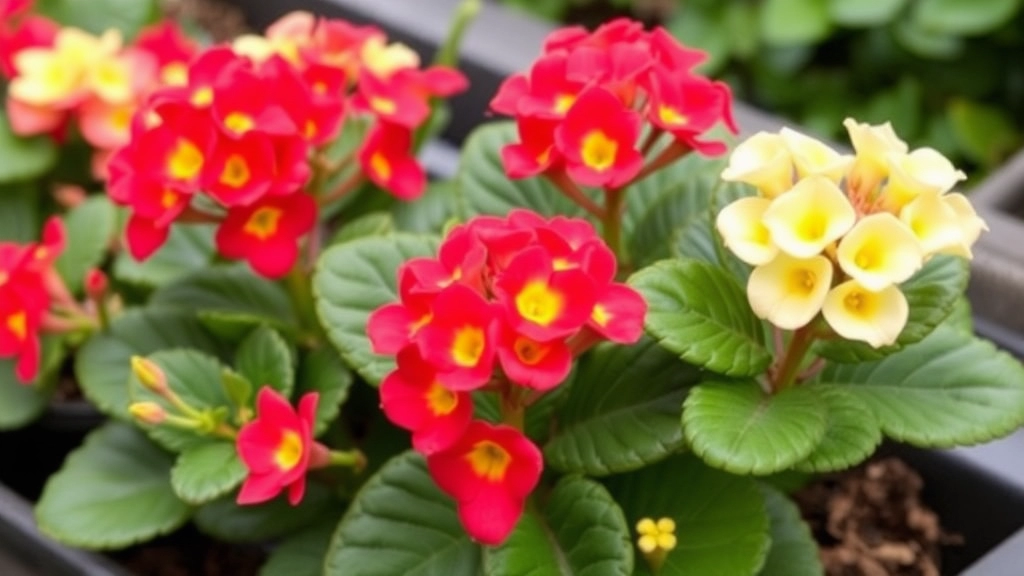
So, you’re keen on nurturing your Kalanchoe, right?
Finding the perfect growing conditions is crucial for keeping this succulent thriving.
Light and Location
Kalanchoe loves bright light.
Aim for at least 6 hours of indirect sunlight daily.
A south-facing window is ideal, but be careful of harsh afternoon rays.
Temperature
Kalanchoe prefers warm temperatures, ideally between 20°C to 25°C (68°F to 77°F).
Keep it away from chilly drafts or sudden temperature drops.
Humidity
Low humidity is the name of the game.
Kalanchoe thrives in dry conditions, so don’t worry about misting it.
Soil
Well-draining soil is a must.
A cactus or succulent mix works wonders.
You can even make your own with:
- Potting soil
- Sand
- Perlite
Potting
Choose a pot with drainage holes.
This helps prevent root rot, which Kalanchoe absolutely hates.
Fertilising
During the growing season, a diluted cactus fertiliser every month can boost growth.
Just don’t overdo it; less is often more!
Benefits of Full Sun for Kalanchoe
If you’re considering the best way to nurture your Kalanchoe, understanding the benefits of full sun exposure is crucial.
Enhanced Growth and Blooming
Kalanchoe thrives in bright light, and full sun can significantly boost its growth and flowering potential.
- Vibrant Blooms: With adequate sunlight, Kalanchoe produces more flowers, showcasing its beautiful, vibrant colours. For more tips on achieving vibrant blooms, check out our complete guide for vibrant blooms.
- Stronger Structure: Full sun encourages a sturdier plant, making it less susceptible to pests and diseases.
Improved Photosynthesis
Sunlight is essential for photosynthesis, the process by which plants convert light energy into chemical energy.
- Energy Production: More sunlight means more energy for your Kalanchoe, resulting in healthier foliage and robust growth.
- Nutrient Absorption: Enhanced photosynthesis leads to better nutrient uptake, making your Kalanchoe more resilient. Learn more about the benefits of sunlight and other care tips in our essential fall Kalanchoe care tips.
Natural Pest Deterrent
A well-lit environment can help keep pests at bay.
- Fewer Pests: Kalanchoe exposed to full sun often experiences fewer pest issues, as many pests prefer shady, humid conditions.
- Healthier Leaves: Well-lit leaves are less likely to develop mould or mildew, promoting overall plant health.
Increased Resilience
A Kalanchoe that receives full sun is generally more resilient to environmental stressors.
- Drought Tolerance: These plants can withstand periods of drought better, as they adapt to their sunny surroundings.
- Temperature Regulation: Full sun exposure helps Kalanchoe regulate its internal temperature, making it less prone to shock.
Potential Risks of Full Sun Exposure

While full sun can be beneficial for Kalanchoe, it’s essential to be aware of the potential risks associated with excessive sunlight. Many plant enthusiasts often worry about whether their Kalanchoe can thrive under intense sun conditions.
1. Leaf Scorch
One of the primary risks is leaf scorch.
- Signs of Scorch: Yellowing or browning edges of the leaves.
- Prevention: Gradually acclimatise your plant to full sun to avoid sudden exposure.
2. Dehydration
Full sun can lead to faster evaporation of moisture.
- Symptoms: Wilting or shrivelling leaves.
- Solution: Regularly check the soil moisture and adjust your watering routine accordingly.
3. Pest Infestations
In some cases, increased sunlight can attract pests.
- Common Pests: Aphids and spider mites.
- Prevention: Regularly inspect your plant and keep the surrounding area clean.
4. Stunted Growth
Overexposure to intense sunlight can hinder growth.
- Symptoms: Slower growth rates and smaller leaves.
- Solution: Ensure your Kalanchoe has adequate nutrients and is not stressed from heat.
Adjusting Kalanchoe to Full Sun
Transitioning your Kalanchoe to full sun can be a rewarding experience, but it does require some thoughtful adjustments. You may wonder how to ensure your plant thrives under more intense light conditions without suffering from stress.
Signs of Sun Stress in Kalanchoe
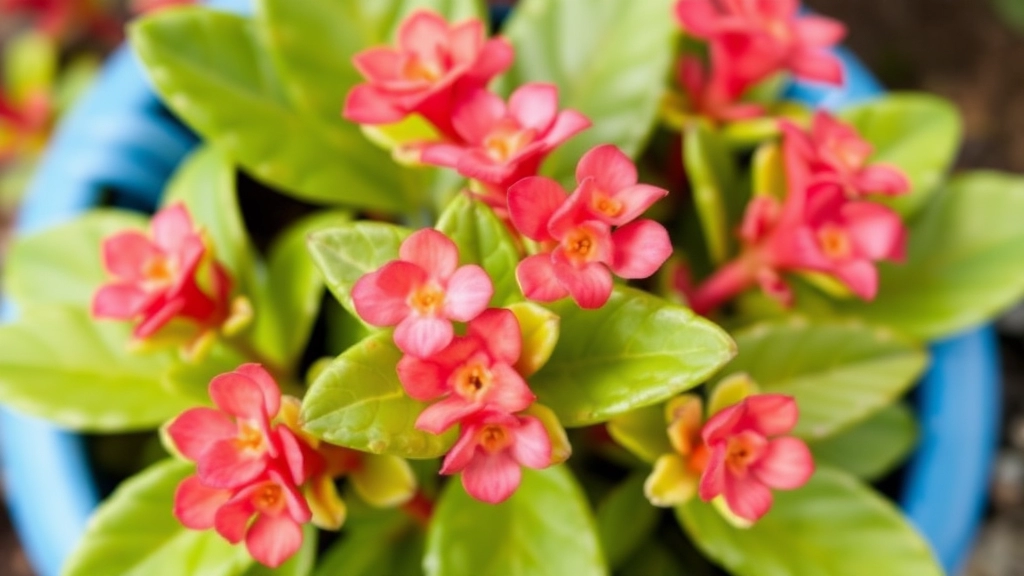
So, you’ve got your Kalanchoe soaking up that glorious sun, but how do you know if it’s too much?
Common Signs of Sun Stress:
- Leaf Discoloration: If the leaves start turning yellow or brown, that’s your first red flag. Healthy Kalanchoe leaves should be vibrant and green.
- Leaf Curling: Curling leaves can indicate that your plant is trying to protect itself from the harsh rays.
- Sunburned Spots: Look out for crispy, brown patches on the leaves. This is a sure sign that your Kalanchoe is feeling the heat a bit too much.
- Dropping Leaves: If you notice leaves dropping off, it might be a cry for help.
- Stunted Growth: If your plant isn’t growing like it used to, it could be struggling with too much sun exposure.
If you spot any of these signs, don’t panic. It’s time to reassess its sun exposure and adjust accordingly.
Best Practices for Watering in Full Sun
When caring for Kalanchoe in full sun, one of the most pressing concerns is how to effectively manage watering. Over or under-watering can lead to stress, especially in bright conditions.
Key Considerations for Watering
- Frequency: During the hottest months, Kalanchoe may require more frequent watering. Check the soil every few days.
- Soil Moisture: Ensure the top inch of soil is dry before watering again. This prevents root rot while keeping the plant hydrated. For more detailed guidance, check out our complete guide on how often to water Kalanchoe.
- Time of Day: Watering in the early morning is ideal. This allows the plant to absorb moisture before the heat of the day.
- Drainage: Always use pots with drainage holes to prevent water from pooling, which can lead to root issues.
Watering Technique
- Deep Watering: Water thoroughly until it runs out of the drainage holes. This encourages deep root growth.
- Avoid Foliage: Try to water the soil directly, avoiding the leaves. This helps prevent fungal issues. For more tips on preventing common issues, visit our page on treating powdery mildew on Kalanchoe plants.
Special Circumstances
- Heat Waves: During extreme heat, consider misting the leaves lightly in the evening to provide a bit of relief.
- Signs of Thirst: Look for drooping leaves or shrivelling as indicators that your Kalanchoe needs water.
Soil and Potting Tips for Sun-exposed Kalanchoe
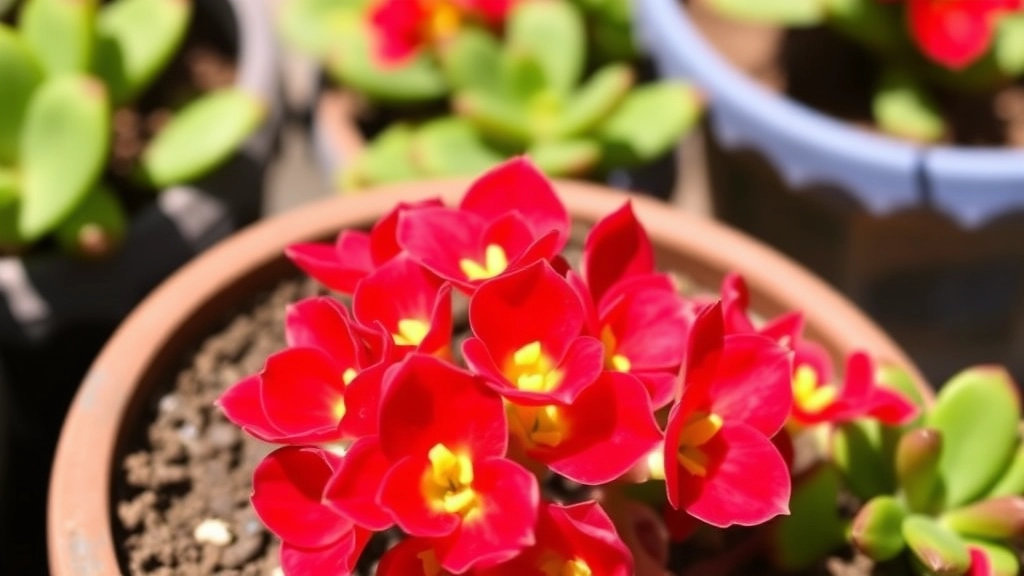
So, you’ve got your Kalanchoe soaking up the sun, and now you’re wondering about the best soil and potting tips to keep it thriving.
What Soil Works Best?
Kalanchoes love well-draining soil. Here’s what I recommend:
- Cactus Mix: A ready-made cactus or succulent mix is perfect.
- DIY Mix: If you want to get crafty, mix equal parts of:
- Potting soil
- Perlite or coarse sand
- Pumice
This combo ensures good drainage, preventing root rot.
Potting Tips
Getting the right pot is just as crucial. Here’s what to keep in mind:
- Drainage Holes: Always choose pots with drainage holes. This helps excess water escape.
- Size Matters: Go for a pot that’s slightly larger than the root ball. Too big, and it’ll hold too much moisture.
- Material: Terracotta pots are great for sun-exposed Kalanchoe. They breathe well and help dry out the soil faster.
Repotting Time
You might be wondering when to repot. Here’s a quick guide:
- Every 2-3 Years: This keeps the soil fresh and nutrients up to date.
- Spring: The best time to repot is during the growing season.
By using the right soil and potting techniques, your Kalanchoe will flourish in full sun.
Seasonal Care for Kalanchoe in Full Sun
As we delve into seasonal care for Kalanchoe exposed to full sun, it’s essential to understand how each season impacts its growth and health.
Spring: Awakening and Growth
Spring is the time when Kalanchoe begins to thrive.
- Increase Watering: As temperatures rise, ensure the soil remains slightly moist but never soggy.
- Fertilisation: Use a balanced fertiliser every four weeks to encourage robust growth.
- Pruning: Trim any dead or wilted leaves to promote new growth and maintain shape.
Summer: Peak Sun Exposure
During summer, Kalanchoe will bask in the sun, and it’s crucial to monitor its well-being.
- Watering Schedule: Water more frequently, especially during heatwaves.
- Shade Options: Consider providing some afternoon shade to prevent leaf scorch.
- Pest Monitoring: Keep an eye out for pests like aphids and mealybugs, which may thrive in warm conditions.
Autumn: Preparing for Dormancy
As temperatures begin to cool, Kalanchoe will start preparing for dormancy.
- Reduce Watering: Cut back on watering as growth slows down.
- Fertilisation: Stop fertilising to allow the plant to rest.
- Cleaning: Wipe leaves to remove dust and improve light absorption.
Winter: Dormant Period
In winter, Kalanchoe enters its dormant phase, requiring minimal care.
Companion Plants for Kalanchoe in Sunny Spots
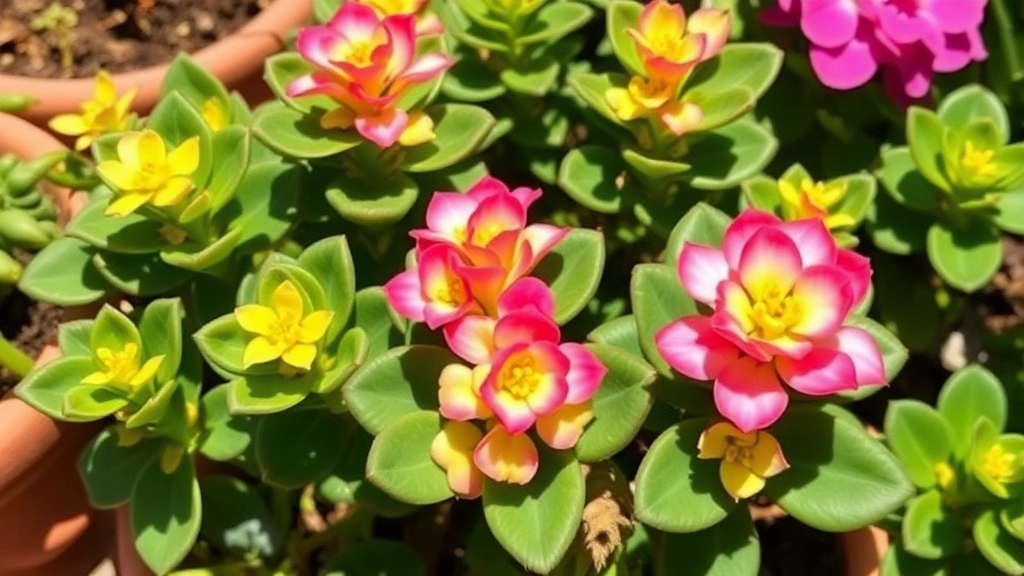
So, you’ve got your Kalanchoe basking in the sun, and now you’re wondering, “What else can I plant alongside it?”
Choosing the right companions can really enhance the beauty of your garden while ensuring all your plants thrive together.
Here are some fab options that play nicely with Kalanchoe:
- Sedum: Tough and drought-resistant, they share similar care needs. Plus, they come in various colours and textures.
- Aloe Vera: Not only does it look great, but it also offers health benefits. Aloe loves the sun just as much as Kalanchoe.
- Echeveria: These rosette-shaped succulents add a lovely contrast and are perfect for sunny spots.
- Portulaca (Moss Rose): These vibrant flowers thrive in full sun and can add a splash of colour to your garden.
- Agave: With their striking architectural form, they provide a dramatic backdrop and love sunny conditions.
- Lavender: Not only does it smell divine, but it also attracts pollinators. Just ensure it has well-drained soil.
When pairing plants, consider their water needs and growth habits to avoid competition for resources.
Remember, the goal is to create a harmonious garden that showcases each plant’s unique charm.
Common Mistakes to Avoid with Sun Exposure
As we delve deeper into the care of Kalanchoe in full sun, it’s essential to identify common pitfalls that can hinder its growth and health.
1. Overexposure to Direct Sunlight
Many enthusiasts believe that more sun equals better growth. However, too much direct sunlight can lead to leaf scorch.
- Tip: Gradually acclimatise your Kalanchoe to full sun. Start with a few hours of exposure and increase it over time.
2. Ignoring Water Needs
In full sun, Kalanchoe may require more frequent watering.
- Tip: Check the soil moisture regularly. Water when the top inch of soil feels dry.
3. Using Poor Quality Soil
Not all potting mixes are created equal. A heavy, water-retaining mix can suffocate the roots.
- Tip: Opt for a well-draining cactus or succulent mix to ensure proper aeration.
4. Neglecting Fertilisation
Some growers assume that a plant in full sun doesn’t need fertilisation.
- Tip: Use a balanced fertiliser during the growing season to promote vibrant blooms.
5. Planting Too Close Together
Companion planting can be beneficial, but overcrowding can lead to competition for sunlight.
- Tip: Ensure adequate spacing between plants to allow each Kalanchoe to receive sufficient light.
6. Failing to Monitor for Pests
Full sun can attract certain pests that thrive in warm conditions.
- Tip: Regularly inspect your plants for signs of pests and treat promptly.
7. Forgetting Seasonal Changes
As the seasons change, so do sunlight conditions.
- Tip: Adjust the placement of your Kalanchoe to ensure it receives the right amount of light throughout the year.
For more detailed care tips, you can refer to our Complete Care Guide for Kalanchoe Tubiflora and learn about Why Your Kalanchoe Leaves Are Turning Brown.
FAQs on Growing Kalanchoe in Full Sun
Can Kalanchoe Take Full Sun?
Yes, Kalanchoe can take full sun, but it’s crucial to acclimatise the plant gradually to avoid sun stress. Start by exposing it to a few hours of direct sunlight and gradually increase the duration.
What Are the Ideal Growing Conditions for Kalanchoe?
Kalanchoe thrives in bright, indirect sunlight for at least 6 hours daily. It prefers warm temperatures between 20°C to 25°C (68°F to 77°F) and low humidity. Well-draining soil, such as a cactus or succulent mix, is essential.
What Are the Risks of Full Sun Exposure for Kalanchoe?
Full sun exposure can lead to several issues, including:
- Leaf Scorch: Yellowing or browning edges of the leaves.
- Dehydration: Wilting or shrivelling leaves.
- Pest Infestations: Increased risk of aphids and spider mites.
- Stunted Growth: Slower growth rates and smaller leaves.
What Are the Signs of Sun Stress in Kalanchoe?
Common signs of sun stress include:
- Leaf Discoloration: Yellow or brown leaves.
- Leaf Curling: Leaves curling to protect themselves from the sun.
- Sunburned Spots: Crispy, brown patches on the leaves.
- Dropping Leaves: Leaves falling off the plant.
- Stunted Growth: Reduced growth rate.
What Soil and Potting Tips Should I Follow for Sun-Exposed Kalanchoe?
For Kalanchoe in full sun, use well-draining soil like a cactus or succulent mix. Opt for pots with drainage holes to prevent root rot. Terracotta pots are ideal as they breathe well and help dry out the soil faster. Repot every 2-3 years, preferably in spring.
What Are Good Companion Plants for Kalanchoe in Sunny Spots?
Great companion plants for Kalanchoe in sunny areas include:
- Sedum
- Aloe Vera
- Echeveria
- Portulaca (Moss Rose)
- Agave
- Lavender
These plants share similar care needs and can enhance the beauty of your garden.
How Often Should I Water My Kalanchoe in Full Sun?
Watering frequency depends on the soil’s moisture level. Check the soil regularly and water when it’s dry to the touch. Overwatering can lead to root rot, so ensure the soil drains well.
Should I Fertilise My Kalanchoe?
Yes, during the growing season, use a diluted cactus fertiliser once a month. Be cautious not to over-fertilise, as less is often more for Kalanchoe.
What Should I Do If My Kalanchoe Shows Signs of Sun Stress?
If you notice signs of sun stress, such as leaf discoloration or sunburned spots, reduce the amount of direct sunlight. Move the plant to a location with indirect light and gradually reintroduce it to full sun.
References
-
Growing Kalanchoe Indoors
-
Kalanchoe Plant Care Tips
-
Kalanchoe: How to Grow and Care for Kalanchoe Plants
